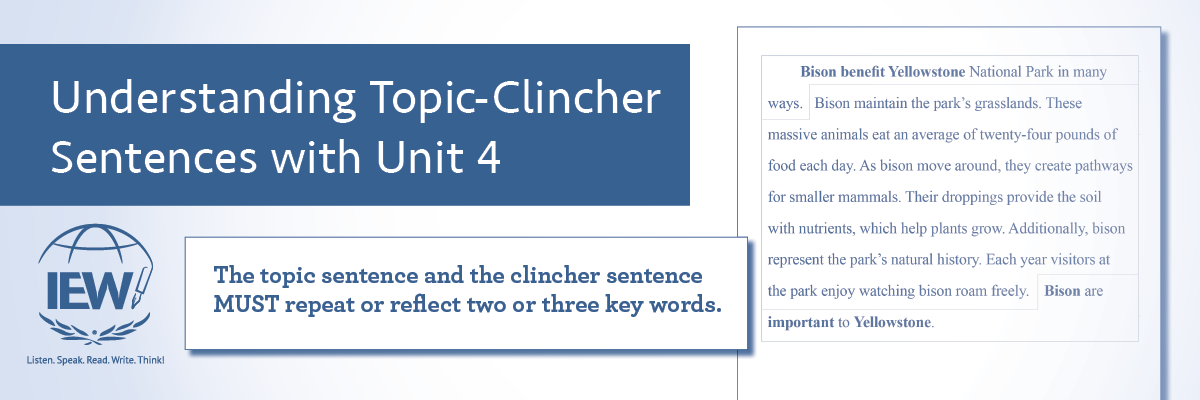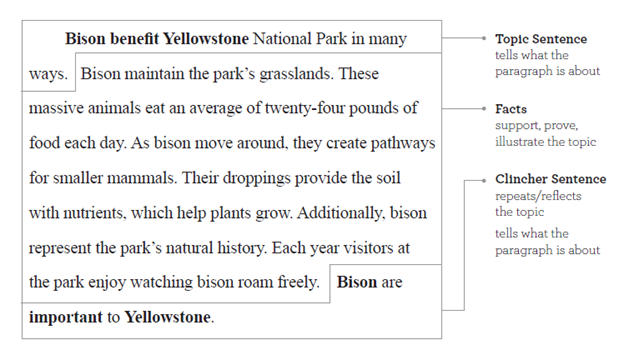
IEW teaches students to write with structure and with style. Style includes vocabulary. Structure is the elements found in compositions. Throughout the year, students progress through nine structural units.
After building a strong foundation with Unit 1 and Unit 2 and then retelling narrative stories by using the Story Sequence Chart with Unit 3, students advance to Unit 4. In this unit students write reports by summarizing a reference. When students write a short report, most often they turn to an encyclopedia, internet article, or a textbook for information. These sources typically have much more information than students need. Mr. Pudewa teaches students to “SOME-a-rize,” meaning students will include some facts from the source text but not every fact.
Instead of writing key words from every sentence, students form the KWO by taking key words from interesting and important facts found in a source text. Instructors and students start with a short source text included in all the theme-based writing lessons and video courses. Every Unit 4 writing assignment begins with a subject. The subject is the thing that is researched—the thing the assignment is about. A subject of a paper may be a person, place, event, animal, or issue. Each paragraph within the assignment is about a specific topic. The topic is the division of the thing that is researched—a thing within the subject.
If the subject (assignment) is farm, the possible topics (paragraphs) may be animals, garden, barn, layout, location, etc. If the subject is dogs (assignment), the possible topics (paragraphs) may be characteristics, senses, behavior, lifespan, breeds, play, domestication, etc. If the subject is Benjamin Franklin (assignment), the possible topics (paragraphs) may be childhood, family, inventions, almanac, Revolutionary War, etc.
When students are writing a report, facts must be organized into paragraphs. Initially younger students will be assigned one topic, which means they will write only one paragraph. As students grow in their writing abilities, they will write several paragraphs about multiple topics related to a single subject. Each paragraph will begin with a topic sentence, contain facts, and end with a clincher sentence.
Topic Sentence
The topic sentence tells what the paragraph is about. Key words are placed on the topic line. For a one-paragraph report, students write the topic word and one more word related to the topic. If the paragraph is about the usefulness of a hammer, the key words on the topic line may be hammer, useful. Every fact on the outline and every sentence in the paragraph then supports or proves the topic: how a hammer is useful.
When writing multi-paragraph compositions, follow the topic line pattern: subject, topic, one more word about the topic. If the assignment is about a horse, the key words on the topic line of the KWO for the first paragraph may be horse, care, imperative. Every fact on the outline and every sentence in the paragraph then supports or proves the topic: the care of a horse is imperative. The key words on the topic line of the KWO for the second paragraph may be horse, training, consistent. Every fact on the outline and sentence in the paragraph then supports or proves the topic: the training of a horse must be consistent. The three key words on the topic line determine the facts that students search for during the research process.
Facts
Facts are written on the other lines of the KWO. Instructors begin by reading the source text with the students and discussing the subject and topics. Encourage students to find interesting or important facts related to the topic. Students transfer those words to the KWO. The rules for writing the KWO remain: write 2-3 key words on each line and use symbols, numbers, and abbreviations when applicable.
Clincher Sentence
The clincher sentence reminds the reader what the paragraph is about. For this reason, it is the last sentence of the paragraph. The KWO ends with the word clincher. Students do not place key words on the clincher line. Instead, when they write their rough drafts, they repeat (same word) or reflect (synonym of the word) two or three key words from the topic line.

After students write their KWO, they should test it. To test a KWO, students put the source text away and use only their notes. If a note is unclear, students should check the source text and fix the KWO. After testing the KWO, students are ready to write a paragraph.
This sample paragraph is from Discoveries in Writing.

Provide plenty of practice for your students to master writing a strong, cohesive paragraph. Mastering the topic-clincher rule and ensuring that every sentence in the paragraph supports and illustrates the topic are foundational skills that students will use for the rest of their academic courses throughout high school, college, and beyond. If students can write one solid paragraph, they will be able to build paragraph upon paragraph into reports and essays of any length.
by Sabrina Cardinale
Originally posted on December 14, 2023
